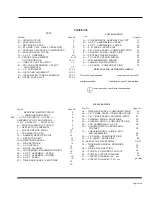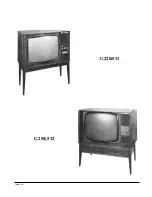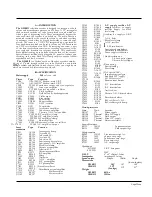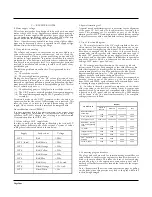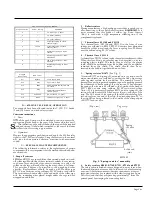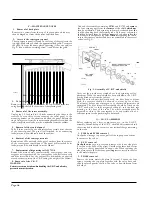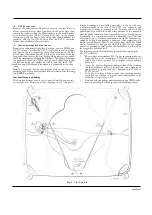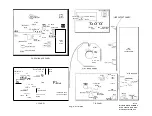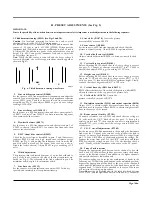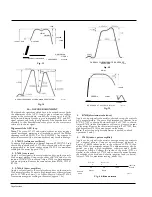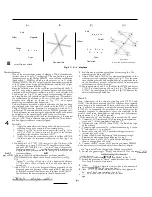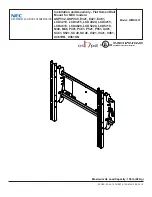
P l u g an d s o ck e t l o c a ti on
t a b le s
P l u g s o c k e t N o .
C o l o u r c o di n g
Loc a tion
I
—
I.F. input on I.F. panel
2
—
I.F. panel (5 leads)
3
—
I.F. panel (6 leads)
4
Red
Convergence plug on centre
chassis (upper)
5
Yellow
Convergence plug on centre
chassis (lower)
6
—
Deflection coil plug on centre
chassis
7
—
Upper plug on side of L.O.P.T.
assemblthe
8
—
Lower plug on side of L.O.P.T.
assembly
9
—
Degaussing coil plug on lower
chassis
P l u gge d
c o n n e c t i o n s
L e a d c o l o u r
L o c a t i o n
Pc!
Rilllack
Tuner supply lead
Pc2
Grey
Tuner A.G.C. lead
Pc3
Black
Earth link between chroma. and
I.F. panels
Pc4
Grey
Chrominance signal feed to
chroma. panel
Pc5
Screened
A.F. output on I.F. panel
Pc6
Brown
Luminance output on I.F. panel
D — 625-LINE V.H.F. RELAY OPERATION
Ten channels have been allocated inside the V.H.F. T.V. bands
(I and III) for use on wired relay systems.
Conversion instructions
1.
Tuner
With all the push buttons in the unlatched position, depress the
appropriate plastic knob at the rear of the tuner and rotate until
-
Nao indication on the end of the knob lines up with the required
,and and system. A label which is attached to the rear of the tuner
wvill assist in this setting-up procedure.
2.
Operation
Depress the appropriate push-button and apply the 625-line relay
signal to the V.H.F. aerial socket. Using the receiver in the normal
way, tune for best picture definition, consistent with maximum
sound.
E
—
SPECIALLY MOUNTED COMPONENTS
The following information relates to the replacement of certain
components; it is very important that the methods described below
are carried out.
1. Drop-off resistors
122111
and R4135 are spaced from their printed panels on stand-
off solder tags. Should one of these resistors overheat for any reason,
such as an inter-electrode short-circuit occurring in a valve, the
solder on the tags will melt, allowing the component to fall away.
This provides a degree of protection to the panels and other
circuitry. Replacements should be made with Dubilier type
BTA 1 watt resistors, using ordinary '60/40' resin-cored solder.
The resistor must be mounted on the underside of the solder tags,
with the connecting wires placed straight under the tags and not
wrapped around them.
2.
Ballast resistors
During manufacture, a high melting point solder is employed on
all connections to the supply ballast resistors
R1052/R1053.
It is
most essential that this grade of solder (e.g. Ersin Comsol
Alloy) is used with a high temperature soldering iron if this
component is replaced.
3.
Thermal fuses FS1108 and FS1110
Two thermal fuses (FS1108 and FS1110) in the form of wire
springs, are soldered on R1052/R1053. Excessive heat dissipation
causes the solder to melt and the fuses to spring free. The fuses
must be refitted using '60/40' solder.
4.
Thermal fuse FS1114
A thermal fuse FS1114 is fitted inside the mains transformer bobbin.
When this fuse blows, tin splashes may be deposited on its sur-
rounding plastic shield. The faulty fuse, as well as the plastic
shield, should be withdrawn from the bobbin, and the tin splashes
removed from the shield. The shield should then be re-
inserted in the bobbin together with a new fuse.
5.
'Spring resistor' R1073
(See Fig. 1)
A resistor R1073 and spring-off, mounted on a tag strip near the
mains transformer, are included to protect the line output stage
valves against certain fault conditions. The assembly forms a
thermal fuse with properties dependent upon the melting point of
the solder used to fix the spring-off to the resistor. When necessary
the spring-off wire must be soldered to the outside of the bend in
R1073 lead-out wire using ordinary '60/40' resin-cored solder.
Note.
—
If it is necessary to replace R1073 and/or spring-off, the
resistor should be carefully fitted across the two end tags of the
strip. The b1/4nt end of the spring-off should be fitted through the
second tag from one end of the strip, then turned approx. 45° to
the strip before being soldered to the outside of the crimped part
of R1073 lead-out wire.
(Top view)
Tag strip
Soldered
joint
SD3880
Fig. I. "Spring resistor" assembly
6.
Safety resistors R4083, R7148, R7151, R7263 and R7293
The safety resistors listed above are designed to act as fuses when
their rated dissipation is exceeded. In the event of a fault causing
any one of these components to become open-circuit, it is most
important that they are replaced with a similar type (see Spare
Parts List) and that they are spaced approximately i" from the
printed panel by crimping the connecting leads.
s
Spring -
off wire
Page Five
Содержание G22K511
Страница 3: ...G22K511 G25K512 Page Two ...
Страница 12: ...Page Ten ...
Страница 14: ...Page Eleven ...
Страница 19: ...Page Fifteen ...


